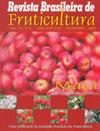与IAC 2019杂交获得的果实种子数和杂种频率
IF 0.9
4区 农林科学
Q4 HORTICULTURE
引用次数: 0
摘要
摘要农科院柑橘中心柑橘育种项目以Murcott IAC tangor (Citrus reticulata x Citrus sinensis)与Pera IAC甜橙(C. sinensis)杂交,培育出柑橘品种IAC 2019Maria。本研究旨在评估IAC 2019Maria mandarin果实中的种子数量,并鉴定IAC 2019Maria mandarin与Pera IAC甜橙和Ponkan mandarin (C. reticulata Blanco)杂交的合子胚胎和三倍体植株,以及IAC 2019Maria mandarin的开放授粉和自花授粉。IAC 2019玛丽亚花自花授粉,用Pera甜橙和Ponkan柑橘的花粉授粉,不授粉。用微卫星分子标记鉴定胚胎,用流式细胞术鉴定胚的倍性。不授粉处理的结果表明,该品种不产生孤雌果实。基因分型结果表明,100%的群体由合子胚组成,表明IAC 2019是一种低多胚植物。杂种的倍性分析可以从与Pera甜橙杂交的流产种子中鉴定出三倍体植株和两个四倍体植株,一个来自Pera甜橙杂交,一个来自自花授粉。本文章由计算机程序翻译,如有差异,请以英文原文为准。
Number of seeds in fruits and frequency of hybrids obtained in crossings with IAC 2019 Maria mandarin
Abstract The Citrus Breeding Program of the Citriculture Center at the Agronomic Institute (IAC) has developed a mandarin cultivar IAC 2019Maria from the crossing between Murcott IAC tangor (Citrus reticulata x Citrus sinensis) and Pera IAC sweet orange (C. sinensis). The present study aimed to assess the number of seeds in fruits of IAC 2019Maria mandarin and to identify zygotic embryos and triploid plants in the crossings between IAC 2019Maria mandarin, Pera IAC sweet orange, and Ponkan mandarin (C. reticulata Blanco), in addition to IAC 2019Maria mandarin in open and self-pollination. IAC 2019Maria flowers were self-pollinated, pollinated with pollen from Pera sweet orange and Ponkan mandarin, and had no pollination. The embryos were identified using microsatellite molecular markers and ploidy was assessed by flow cytometry. The results of the treatment with no pollination suggest the variety does not produce parthenocarpic fruits. The genotyping results showed that 100% of the populations consist of zygotic embryos, suggesting that IAC 2019Maria mandarin is a plant with low polyembryony. The ploidy analysis of the hybrids allowed identifying a triploid plant from an aborted seed from the crossing with Pera sweet orange and two tetraploids, one from the crossing with Pera sweet orange and one from self-pollination.
求助全文
通过发布文献求助,成功后即可免费获取论文全文。
去求助
来源期刊
CiteScore
1.50
自引率
20.00%
发文量
34
审稿时长
4-8 weeks
期刊介绍:
The Revista Brasileira de Fruticultura (RBF) publishes technical articles and scientific communications in the area of fruit crops, referring to results of original searches and unpublished papers in Portuguese, Spanish or English, and 1 or 2 reviews per edition, of invited authors.

 求助内容:
求助内容: 应助结果提醒方式:
应助结果提醒方式:


